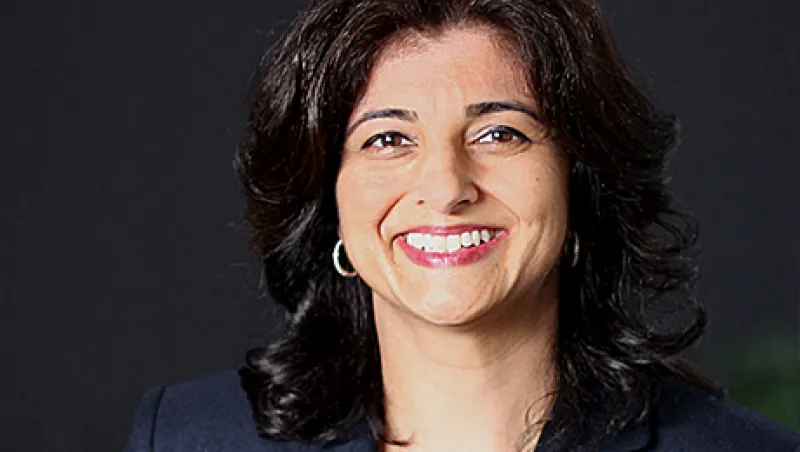Seema Hingorani has a vision: By 2030 she wants to see 30 percent of the world’s investable capital managed by women. To help create all of the female portfolio managers and chief investment officers who will be needed, in April the former CIO of the New York City retirement system launched Girls Who Invest; she’s already achieved some of her early goals.
The motivation for Hingorani’s nonprofit, which aims to get female liberal arts students interested in the investment business, is the so-called pipeline problem: In recent years a shrinking number of women have chosen asset management as a career. Only about 7 percent of U.S. mutual fund assets are managed by women, down from 10 percent in 2009, according to Chicago-based Morningstar. The industry is in dire need of new blood if Hingorani is to meet her goal.
Numerous studies suggest that workplace diversity is good for business. Catalyst, a New York–based group dedicated to expanding opportunities for women, draws on this research to cite a variety of benefits, from better financial performance to increased innovation.
Biases within the industry help explain the shortage of female investment professionals, but that’s only part of the problem. Even firms with diversity programs that try to recruit female staff find a tiny pool of candidates.
When she began researching a structure and curriculum for Girls Who Invest, Hingorani, a Yale University graduate who also holds an MBA from the Wharton School of the University of Pennsylvania, visited the latter’s Philadelphia campus to talk to a group of 50 female students. When she asked if they thought asset management was a noble profession, no one raised a hand.
Hingorani, 46, says three roadblocks deter girls and young women from aspiring to become money managers. The first: “Since the global financial crisis, there’s a cloud that’s been cast over our industry,” she says. “Six years later it still exists.”
Second, when younger females don’t see many women in senior investment roles, they doubt their ability to compete in a male-dominated profession. The third obstacle, according to Hingorani: Many girls simply don’t know that this stimulating, rewarding and potentially lucrative career is available to them.
Hingorani, who stepped down in mid-2014 as interim CIO of the $160 billion New York pension system, where she previously served as head of public equity and hedge funds, has put her career on hold to build the college-level program for rising sophomores and juniors. The pilot for Girls Who Invest will get under way in Philadelphia next summer, when 30 female students from UPenn and other local schools, including Temple University and Bryn Mawr College, will participate in a four-week intensive residential program on the UPenn campus.
“We want to target liberal arts majors,” says Hingorani, whose own entry into asset management was accidental. Having planned for a career in law after majoring in psychology and philosophy at Yale, she took a job as a junior research analyst at investment bank Donaldson, Lufkin & Jenrette without any formal training and found her passion for investing.
Professors from UPenn and other colleges will teach Girls Who Invest students about capital markets and the ecosystem of asset management, explains Hingorani, who hopes that participants will decide to take subjects like economics and accounting when they return to regular studies. Ideally, there will be a summer internship for everyone who finishes the program.
Eventually, Hingorani wants to take Girls Who Invest nationwide, beginning with a summer program for 100 young women in New York slated for 2017, then branching out in 2018 to Chicago and California. Later, she hopes to create clubs in high schools across the country: “How cool would it be to have thousands of girls and young women excited about investing?”
She stresses the importance of mentors, including her own, James Kennedy, president and CEO of investment management giant T. Rowe Price, where she spent four years as a Baltimore-based equity analyst before moving into the hedge fund world at Andor Capital Management, Pequot Capital Management and Mirador Capital Management. “We need to partner with the men in our business to get this done,” Hingorani says. “We can’t do it alone.”
This isn’t Hingorani’s first foray into nonprofit work. Prior to joining the New York system in 2010, she stepped away from money management for several years to pursue efforts that included supporting girls’ education in India, where she funded the construction of a library in a village school to honor her late India-born father, Ram. Hingorani says that her interest in public service was inspired by her dad — a former city councilor in her hometown of Norwalk, Connecticut — and by Hillary Clinton.
Having worked for Clinton in 2007–’08 as a member of her presidential campaign’s national finance committee, Hingorani now sits on her tri-state finance committee.
For her new project, Hingorani has enlisted some powerful allies. Girls Who Invest’s eight-member board includes Jane Buchan, co-founder and CEO of Pacific Alternative Asset Management Co.; William Goetzmann, a finance and management professor at Yale; and Larry Schloss, president of alternative-investment firm Angelo, Gordon & Co. and Hingorani’s former boss at the New York funds. Hingorani is also seeking five sponsors and has already signed one: Robert Smith, founder, chair and CEO of Vista Equity Partners, a private equity firm based in Austin, Texas.
Hingorani has a message for firms whose efforts to hire female talent haven’t worked as hoped. “Give us the money that you have been spending on recruiting to attract more young women into investing positions,” she says. “We’ll create a massive pipeline for you of talented and vetted women who are excited and prepared to succeed in the asset management business.”






